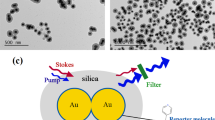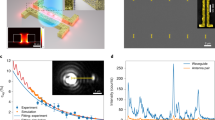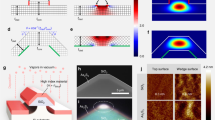Abstract
Raman-based technologies have enabled many ground-breaking scientific discoveries related to surface science, single-molecule chemistry and biology. For example, researchers have identified surface-bound molecules by their Raman vibrational modes and demonstrated polarization-dependent Raman gain. However, a surface-constrained Raman laser has yet to be demonstrated because of the challenges associated with achieving a sufficiently high photon population located at a surface to transition from spontaneous to stimulated Raman scattering. Here, advances in surface chemistry and in integrated photonics are combined to demonstrate lasing based on surface stimulated Raman scattering (SSRS). By creating an oriented, constrained Si–O–Si monolayer on the surface of integrated silica optical microresonators, the requisite conditions for SSRS are achieved with low threshold powers (200 μW). The expected polarization dependence of SSRS due to the orientation of the Si–O–Si bond is observed. Owing to the ordered monolayer, the Raman lasing efficiency is improved from ~5% to over 40%.
This is a preview of subscription content, access via your institution
Access options
Access Nature and 54 other Nature Portfolio journals
Get Nature+, our best-value online-access subscription
$29.99 / 30 days
cancel any time
Subscribe to this journal
Receive 12 print issues and online access
$209.00 per year
only $17.42 per issue
Buy this article
- Purchase on Springer Link
- Instant access to full article PDF
Prices may be subject to local taxes which are calculated during checkout






Similar content being viewed by others
Data availability
The data that support the plots with this paper and other findings of this study are available from the corresponding authors upon reasonable request.
References
Minck, R. W., Terhune, R. W. & Rado, W. G. Laser-stimulated Raman effect and resonant four-photon interactions in gases H2, D2, and CH4. Appl. Phys. Lett. 3, 181–184 (1963).
Stolen, R. Polarization effects in fiber Raman and Brillouin lasers. IEEE J. Quant. Electron. 15, 1157–1160 (1979).
Karpov, V. I. et al. Laser-diode-pumped phosphosilicate-fiber Raman laser with an output power of 1 W at 1.48 µm. Opt. Lett. 24, 887–889 (1999).
Benabid, F., Knight, J., Antonopoulos, G. & Russell, P. Stimulated Raman scattering in hydrogen-filled hollow-core photonic crystal fiber. Science 298, 399–402 (2002).
Rong, H. et al. An all-silicon Raman laser. Nature 433, 292–294 (2005).
Feve, J.-P. M., Shortoff, K. E., Bohn, M. J. & Brasseur, J. K. High average power diamond Raman laser. Opt. Express 19, 913–922 (2011).
Liu, X. et al. Integrated continuous-wave aluminum nitride Raman laser. Optica 4, 893–896 (2017).
Eckhardt, G., Bortfeld, D. & Geller, M. Stimulated emission of Stokes and anti-Stokes Raman lines from diamond, calcite, and α-sulfur single crystals. Appl. Phys. Lett. 3, 137–138 (1963).
Pan, A. et al. Stimulated emissions in aligned CdS nanowires at room temperature. J. Phys. Chem. B 109, 24268–24272 (2005).
Hokr, B. H. et al. Bright emission from a random Raman laser. Nat. Commun. 5, 4356 (2014).
Basiev, T. New crystals for Raman lasers. Phys. Solid State 47, 1400–1405 (2005).
Latawiec, P. et al. On-chip diamond Raman laser. Optica 2, 924–928 (2015).
Raymer, M. G., Mostowski, J. & Carlsten, J. L. Theory of stimulated Raman scattering with broad-band lasers. Phys. Rev. A 19, 2304–2316 (1979).
Raman, C. & Krishnan, K. A new type of secondary radiation. Nature 121, 501–502 (1928).
Heritage, J. P. in Picosecond Phenomena II (eds Shank, C. V. et al.) 343–347 (Springer Berlin Heidelberg, 1980).
Cazzanelli, M. & Schilling, J. Second order optical nonlinearity in silicon by symmetry breaking. Appl. Phys. Rev. 3, 011104 (2016).
Zhang, X. et al. Symmetry-breaking-induced nonlinear optics at a microcavity surface. Nat. Photon. 13, 21–24 (2019).
Jalali, B., Raghunathan, V., Dimitropoulos, D. & Boyraz, O. Raman-based silicon photonics. IEEE J. Sel. Top. Quant. Electron. 12, 412–421 (2006).
Wei, H. et al. Polarization dependence of surface-enhanced Raman scattering in gold nanoparticle-nanowire systems. Nano Lett. 8, 2497–2502 (2008).
Presser, V. et al. Raman polarization studies of highly oriented organic thin films. J. Raman Spectrosc. 40, 2015–2022 (2009).
Shen, Y. R. Nonlinear optical studies of surfaces. Appl. Phys. A 59, 541–543 (1994).
Vahala, K. Optical microcavities. Nature 424, 839–846 (2003).
Shi, C., Soltani, S. & Armani, A. M. Gold nanorod plasmonic upconversion microlaser. Nano Lett. 13, 5827–5831 (2013).
Maker, A. J. & Armani, A. M. Nanowatt threshold, alumina sensitized neodymium laser integrated on silicon. Opt. Express 21, 27238–27245 (2013).
Castro-Beltrán, R., Diep, V. M., Soltani, S., Gungor, E. & Armani, A. M. Plasmonically enhanced Kerr frequency combs. ACS Photon. 4, 2828–2834 (2017).
Choi, H. & Armani, A. M. Raman–Kerr frequency combs in Zr-doped silica hybrid microresonators. Opt. Lett. 43, 2949–2952 (2018).
Ma, J., Jiang, X. & Xiao, M. Kerr frequency combs in large-size, ultra-high-Q toroid microcavities with low repetition rates. Photon. Res. 5, B54–B58 (2017).
Ilchenko, V. & Matsko, A. Optical resonators with whispering-gallery modes—part II: applications. IEEE J. Sel. Top. Quant. Electron. 12, 15–32 (2006).
Spillane, S. M., Kippenberg, T. J. & Vahala, K. J. Ultralow-threshold Raman laser using a spherical dielectric microcavity. Nature 415, 621–623 (2002).
Choi, H. & Armani, A. M. High efficiency Raman lasers based on Zr-doped silica hybrid microcavities. ACS Photon. 3, 2383–2388 (2016).
Dimitropoulos, D., Houshmand, B., Claps, R. & Jalali, B. Coupled-mode theory of the Raman effect in silicon-on-insulator waveguides. Opt. Lett. 28, 1954–1956 (2003).
Sabella, A., Piper, J. A. & Mildren, R. P. 1240 nm diamond Raman laser operating near the quantum limit. Opt. Lett. 35, 3874–3876 (2010).
Chen, C.-Y. et al. Understanding the interplay between molecule orientation and graphene using polarized Raman spectroscopy. ACS Photon. 3, 985–991 (2016).
Armani, D., Kippenberg, T., Spillane, S. & Vahala, K. Ultra-high-Q toroid microcavity on a chip. Nature 421, 925–928 (2003).
Facchetti, A. et al. Strategies for electrooptic film fabrication. Influence of pyrrole-pyridine-based dibranched chromophore architecture on covalent self-assembly, thin-film microstructure, and nonlinear optical response. J. Am. Chem. Soc. 128, 2142–2153 (2006).
Schlecht, C. A. & Maurer, J. A. Functionalization of glass substrates: mechanistic insights into the surface reaction of trialkoxysilanes. RSC Adv. 1, 1446–1448 (2011).
Newton, M. D. & Gibbs, G. V. Ab initio calculated geometries and charge distributions for H4SiO4 and H6Si2O7 compared with experimental values for silicates and siloxanes. Phys. Chem. Miner. 6, 221–246 (1980).
Tyaginov, S., Sverdlov, V., Starkov, I., Goes, W. & Grasser, T. Impact of O-Si-O bond angle fluctuations on the Si-O bond-breakage rate. Microelectron. Reliab. 49, 998–1002 (2009).
Hunt, H. K., Soteropulos, C. & Armani, A. M. Bioconjugation strategies for microtoroidal optical resonators. Sensors 10, 9317–9336 (2010).
Zhao, W., He, A. & Xu, Y. Raman second hyperpolarizability determination using computational Raman activities and a comparison with experiments. J. Phys. Chem. A 117, 6217–6223 (2013).
Goda, K., Mahjoubfar, A. & Jalali, B. Demonstration of Raman gain at 800 nm in single-mode fiber and its potential application to biological sensing and imaging. Appl. Phys. Lett. 95, 251101 (2009).
Mookherjea, S. & Yariv, A. Coupled resonator optical waveguides. IEEE J. Sel. Top. Quant. Electron. 8, 448–456 (2002).
Deka, N., Maker, A. J. & Armani, A. M. Titanium-enhanced Raman microcavity laser. Opt. Lett. 39, 1354–1357 (2014).
Hollenbeck, D. & Cantrell, C. D. Multiple-vibrational-mode model for fiber-optic Raman gain spectrum and response function. J. Opt. Soc. Am. B 19, 2886–2892 (2002).
Yu, Y. et al. New C-H stretching vibrational spectral features in the Raman spectra of gaseous and liquid ethanol. J. Phys. Chem. C 111, 8971–8978 (2007).
Shen, X., Castro Beltran, R., Diep, V. M., Soltani, S. & Armani, A. M. Low-threshold parametric oscillation in organically modified microcavities. Sci. Adv. 4, eaao4507 (2018).
Ye, Y. et al. Monolayer excitonic laser. Nat. Photon. 9, 733–737 (2015).
Longhi, S. & Feng, L. Unidirectional lasing in semiconductor microring lasers at an exceptional point. Photon. Res. 5, B1–B6 (2017).
Yao, B. et al. Gate-tunable frequency combs in graphene–nitride microresonators. Nature 558, 410–414 (2018).
Reeves, L., Wang, Y. & Krauss, T. F. 2D material microcavity light emitters: to lase or not to lase? Adv. Opt. Mater. 6, 1800272 (2018).
Acknowledgements
We thank Y. Xiao and J. Chen for helpful discussions and M. Veksler for scientific visualization. We would like to acknowledge IARPA (2016-16070100002) and the Office of Naval Research (N00014-17-2270).
Author information
Authors and Affiliations
Contributions
X.S. and H.C. conceived the project. X.S., H.C. and A.M.A. designed the experiments. H.C. fabricated the devices. X.S. functionalized the devices. X.S. and H.C. conducted testing and data analysis. W.Z. conducted DFT simulations of the model molecules. D.C. performed the finite-element method simulations. X.S., H.C. and A.M.A. wrote the manuscript. All authors revised and commented on the manuscript. All authors have given approval to the final version of the manuscript and Supplementary Information.
Corresponding authors
Ethics declarations
Competing interests
The authors declare no competing interests.
Additional information
Publisher’s note Springer Nature remains neutral with regard to jurisdictional claims in published maps and institutional affiliations.
Supplementary information
Supplementary Information
Supplementary details, Figs. 1–6, refs. 1–10 and Tables 1–3.
Rights and permissions
About this article
Cite this article
Shen, X., Choi, H., Chen, D. et al. Raman laser from an optical resonator with a grafted single-molecule monolayer. Nat. Photonics 14, 95–101 (2020). https://doi.org/10.1038/s41566-019-0563-7
Received:
Accepted:
Published:
Issue Date:
DOI: https://doi.org/10.1038/s41566-019-0563-7
This article is cited by
-
Nonlocal bonding of a soliton and a blue-detuned state in a microcomb laser
Communications Physics (2023)
-
Widely-tunable, multi-band Raman laser based on dispersion-managed thin-film lithium niobate microring resonators
Communications Physics (2023)
-
A whispering-gallery scanning microprobe for Raman spectroscopy and imaging
Light: Science & Applications (2023)
-
Broadband high-Q multimode silicon concentric racetrack resonators for widely tunable Raman lasers
Nature Communications (2022)
-
Self-emergence of robust solitons in a microcavity
Nature (2022)



